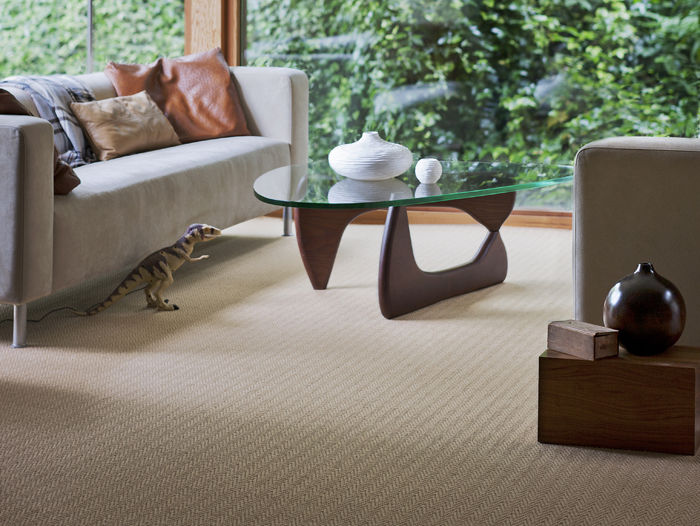Your guide to flooring underlay

Underlay may not be the most exciting part of choosing a new flooring but it is nevertheless crucial to the finished product. Utilising the appropriate flooring underlay brings a whole variety of benefits, such as comfort underfoot, sound and moisture insulation, as well as the reduction of wear and tear.
So what exactly is underlay? Flooring underlay is essentially a barrier or thin layer of cushioning that sits beneath the flooring. Soft underlay tends to be made from materials like foam, rubber or felt, whilst wood or laminate flooring underlays tend to be made from harder materials like wood.
In this post, we will discuss the various types of underlay used for different floors and their corresponding benefits. We will also advise on the flooring underlay used by our team here at Hudson Flooring and provide you with our best recommendations.
Carpet Underlay
Carpet underlay helps to soften the feel of the carpet, making it a more comfortable addition to your home. As well as boasting excellent sound and heat insulation, it also increases the longevity of the carpet by absorbing the above impact wear from foot flow.
Our Ambience underlay, which we use as standard, is 145g/kg3 compared to the brand leader Cloud 9 which is 101g/kg3. We are also proud to say that this underlay is made from recycled material and is therefore an entirely sustainable option. Rubber underlays have a tendency to turn into powder after prolonged heavy use because the oil dissipates over time. We therefore use PU foam underlay, which will last for 10-15 years.
Underfloor Heating Underlay (for Carpet)
We are committed to using only the best underfloor heating underlay in the industry to ensure the best heat transfer without compromising on the great feel underfoot. The maximum combined Tog rating of the carpet and underlay recommended for underfloor heating is 2.5 Togs. Given that carpets are typically 1-1.5 Togs, we use underlay that is only 0.8 Togs so that you gain optimal efficiency.
Although there are underlays on the market at 0.7 Togs, they tend to be hard underfoot in comparison. As there is only a negligible saving of 0.1 Togs, it is simply not worth sacrificing the feel. It is also worth mentioning that slightly softer PU foam underlays for underfloor heating have recently come onto the market. However, we have found that their Tog ratings are for too high, at approximately 1.5-1.7, rendering them inefficient for only a slightly better feel.
Wood / Laminate Flooring Underlay
The wood underlay we use here at Hudson Flooring is recognised as the top standard underlay by the industry. Not only does it provide exceptional sound insulation in the room, it also performs incredibly well under compression tests. As a result, the wood underlay reliably supports the tongue & groove / click system joints for seamless installation and longevity.
In addition, the integrated Damp Proof Membrane provides protection from moisture rising from beneath. This is particularly important with concrete sub-floors and is ten times stronger than the standard polythene Damp Proof Membrane.
Nevertheless, for a truly first-rate installation we strongly recommend a stick-down installation. This entails either nailing the wooden flooring to a timber sub-floor, or adhering the wooden flooring to a concrete sub-floor. By using this method, you can take advantage of a superior solid feel underfoot and prevent creaking when walking across the floor.
Underfloor Heating Underlay (for Wood)
To enable maximum efficiency of your heating system, we use a 0.33 Tog rating wood underlay for underfloor heating. As with the standard wood or laminate underlay, this performs exceptionally well under compression tests, hence supporting the joints of the flooring.
Although it is slightly thinner to allow greater heat transfer, the underlay still provides a hefty 21db of sound insulation. An additional Damp Proof Membrane is required with this underlay, unlike the normal wood or laminate underlay. As above, we recommend a stick-down installation for a superior finish.
Sisal / Plant Fibre Underlay
It is important to note that the requirements for plant fibre underlay are very different from those of a standard carpet. Plant fibre carpets, such as Sisal, expand and contract with changes in moisture levels and temperature in the surrounding environment. They therefore require a fairly rigid crumb rubber underlay and as always, we use the best performing underlay on the market.
The underlay used for plant fibre carpets is fully stuck to the subfloor and the carpet laid over it. Although a very dense underlay that provides superior durability, it still achieves a good feel underfoot. While crumb rubber underlays are not the cheapest, our buying group ensure significant discounts on all of the underlays we offer. This means we can provide our customers with the highest quality end product without the extortionate price tag.
For more information on underlays or any flooring related topic, get in touch with a member of our friendly team today.
